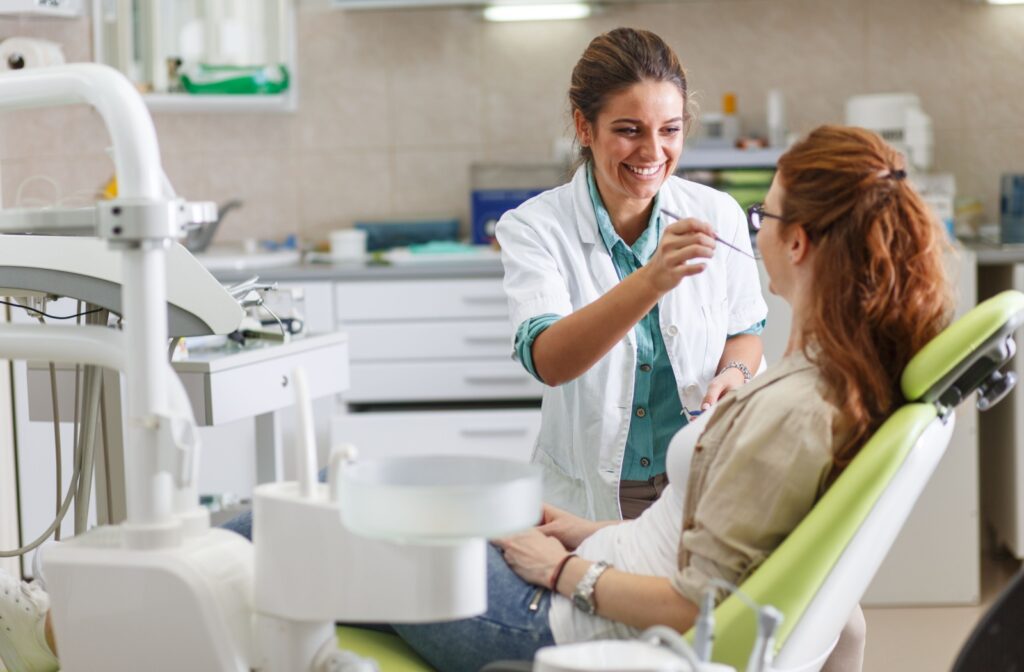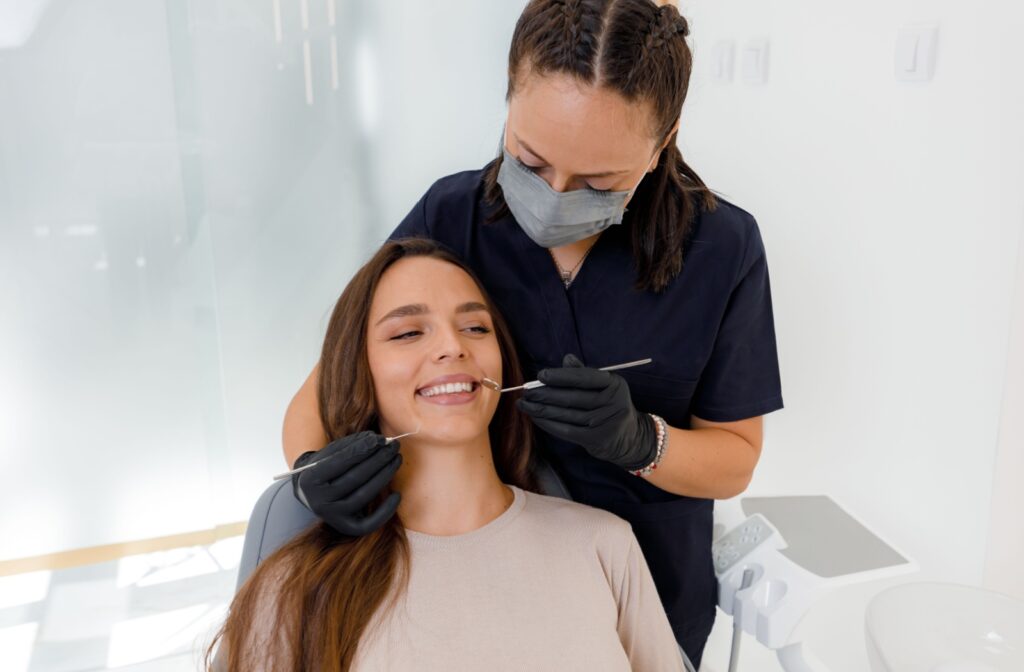Regular dental exams are more than routine check-ups—they’re a key part of maintaining your oral and overall health. These visits help detect issues like cavities, gum disease, and even early signs of conditions like oral cancer.
A full dental exam can include a review of your health history, a professional cleaning, digital X-rays, a visual exam, gum measurements, a bite and jaw assessment, and a post-visit discussion to review findings and next steps.
Benefits of a Full Dental Exam
Regular dental exams are your first line of defence against oral health problems. Early detection of issues like cavities or gum disease allows your dental team to address concerns before they become painful or costly.
But dental exams go beyond your teeth and gums. Your mouth can offer early clues about systemic health issues, including diabetes, heart disease, and even certain cancers. Dentists are trained to spot these signs and can refer you to a healthcare provider when something looks out of the ordinary.
What Happens During a Full Dental Exam?
A comprehensive dental exam includes several key steps that help give your care team a full picture of your oral health. Here’s what you can typically expect.
Before the Exam
The process usually begins with checking in at the front desk and updating your medical history. You may be asked to complete a brief questionnaire to highlight any health changes or concerns. This step is more important than it might seem, as everything from new medications to recent health conditions can impact your oral health.
Sharing that information upfront helps tailor the appointment to your needs and catch issues that might otherwise go unnoticed.
Professional Dental Cleaning
Most full exams are paired with a professional dental cleaning. We’ll start by having a dental hygienist carefully remove plaque and tartar from your teeth—especially in areas that brushing and flossing can’t reach. This helps prevent cavities, gum inflammation, and bad breath.
We may also apply a polish to your teeth and give tips on brushing and flossing techniques.
The Visual Exam
After the cleaning, we’ll visually inspect your teeth, gums, tongue, and other soft tissues. We’re looking for signs of decay, wear and tear, gum disease, and any abnormalities that might need attention. Many dental problems don’t cause symptoms right away, so this is your chance to catch things early—when they’re easiest to treat.
Gum Health Check
Healthy gums are the foundation of a healthy smile. We’ll assess your gum tissue by measuring the depth of the spaces (or “pockets”) between your gums and teeth. Shallow pockets are a good sign, while deeper ones may indicate gum disease.
Early-stage gum disease (gingivitis) is common and reversible. Left untreated, it can progress to more serious issues that affect not just your mouth but your overall health. A quick check during your exam helps keep your gums in top shape.
Dental X-Rays
Digital X-rays allow us to see what’s happening below the surface. These images reveal issues like cavities between teeth, impacted teeth, infections, and even bone loss.
Depending on your dental history, X-rays may be taken at every visit or only occasionally. Some dental clinics also use 3D imaging or panoramic X-rays for a more detailed look at your teeth and jaw structures.
Bite, Spacing & Jaw Joint Evaluation
We may also check how your teeth come together (your bite), the spacing between your teeth, and the health of your jaw joints (also known as temporomandibular joints). Signs of grinding or clenching may be visible, and misalignment can sometimes cause headaches or jaw pain.
Catching these signs early lets us recommend solutions before discomfort sets in or damage occurs.
Oral Cancer Screening
During your dental exam, we’ll also quietly perform an oral cancer screening. This involves checking your lips, tongue, throat, and the insides of your cheeks for any unusual lumps, spots, or changes in colour or texture.
It’s a quick and painless process, but it can be life-saving.
What Happens After the Exam?
At the end of your visit, we’ll walk you through their findings. We’ll explain any issues, recommend next steps if treatment is needed, and answer any questions you have.

This is a great time to ask about daily habits, cosmetic options, or anything else on your mind. Think of it as a one-on-one health consultation for your mouth.
How Often Should You Get a Dental Exam?
Most people benefit from visiting their dentist every 6 months. However, we might suggest a different schedule depending on your needs. If you have a history of gum disease, frequent cavities, or other concerns, more frequent visits may help keep things on track.
By staying on top of your dental exams, you’re doing more than protecting your smile—you’re investing in your long-term health.
Protect Your Smile with Regular Dental Exams
Regular dental exams support both your oral and overall health by helping detect concerns early—often before you notice any symptoms. Knowing what’s included in a full exam can make your visits feel more comfortable and empowering. Keep your smile healthy between visits by brushing twice a day, flossing daily, and making mindful food choices. Ready for your next check-up? Book your dental exam with Shin Dentistry today.



